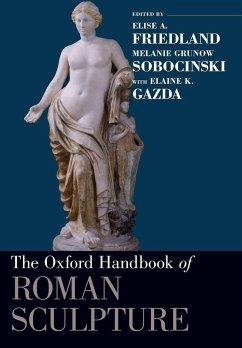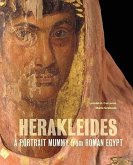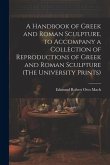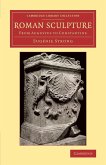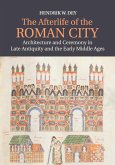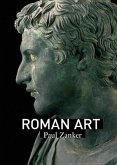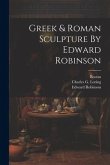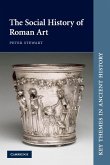Oxford Handbook of Roman Sculpture
Herausgeber: Friedland, Elise A; Gazda, Elaine; Sobocinski, Melanie Grunow
Oxford Handbook of Roman Sculpture
Herausgeber: Friedland, Elise A; Gazda, Elaine; Sobocinski, Melanie Grunow
- Broschiertes Buch
- Merkliste
- Auf die Merkliste
- Bewerten Bewerten
- Teilen
- Produkt teilen
- Produkterinnerung
- Produkterinnerung
The Oxford Handbook of Roman Sculpture synthesizes current best practices for studying this central medium of Roman art, situating it within the larger fields of art history, classical archaeology, and Roman studies.
Andere Kunden interessierten sich auch für
![Herakleides: A Portrait Mummy from Roman Egypt Herakleides: A Portrait Mummy from Roman Egypt]() Lorelei H. CorcoranHerakleides: A Portrait Mummy from Roman Egypt29,99 €
Lorelei H. CorcoranHerakleides: A Portrait Mummy from Roman Egypt29,99 €![A Handbook of Greek and Roman Sculpture, to Accompany a Collection of Reproductions of Greek and Roman Sculpture (The University Prints) A Handbook of Greek and Roman Sculpture, to Accompany a Collection of Reproductions of Greek and Roman Sculpture (The University Prints)]() Edmund Robert Otto MachA Handbook of Greek and Roman Sculpture, to Accompany a Collection of Reproductions of Greek and Roman Sculpture (The University Prints)30,99 €
Edmund Robert Otto MachA Handbook of Greek and Roman Sculpture, to Accompany a Collection of Reproductions of Greek and Roman Sculpture (The University Prints)30,99 €![Roman Sculpture Roman Sculpture]() Eugénie StrongRoman Sculpture61,99 €
Eugénie StrongRoman Sculpture61,99 €![The Afterlife of the Roman City The Afterlife of the Roman City]() Hendrik W. DeyThe Afterlife of the Roman City59,99 €
Hendrik W. DeyThe Afterlife of the Roman City59,99 €![Roman Art Roman Art]() Paul ZankerRoman Art35,99 €
Paul ZankerRoman Art35,99 €![Greek & Roman Sculpture By Edward Robinson Greek & Roman Sculpture By Edward Robinson]() BostonGreek & Roman Sculpture By Edward Robinson26,99 €
BostonGreek & Roman Sculpture By Edward Robinson26,99 €![The Social History of Roman Art The Social History of Roman Art]() Peter StewartThe Social History of Roman Art42,99 €
Peter StewartThe Social History of Roman Art42,99 €-
-
-
The Oxford Handbook of Roman Sculpture synthesizes current best practices for studying this central medium of Roman art, situating it within the larger fields of art history, classical archaeology, and Roman studies.
Hinweis: Dieser Artikel kann nur an eine deutsche Lieferadresse ausgeliefert werden.
Hinweis: Dieser Artikel kann nur an eine deutsche Lieferadresse ausgeliefert werden.
Produktdetails
- Produktdetails
- Verlag: Hurst & Co.
- Seitenzahl: 728
- Erscheinungstermin: 1. September 2018
- Englisch
- Abmessung: 249mm x 168mm x 33mm
- Gewicht: 1202g
- ISBN-13: 9780190887001
- ISBN-10: 0190887001
- Artikelnr.: 56971790
- Herstellerkennzeichnung
- Libri GmbH
- Europaallee 1
- 36244 Bad Hersfeld
- gpsr@libri.de
- Verlag: Hurst & Co.
- Seitenzahl: 728
- Erscheinungstermin: 1. September 2018
- Englisch
- Abmessung: 249mm x 168mm x 33mm
- Gewicht: 1202g
- ISBN-13: 9780190887001
- ISBN-10: 0190887001
- Artikelnr.: 56971790
- Herstellerkennzeichnung
- Libri GmbH
- Europaallee 1
- 36244 Bad Hersfeld
- gpsr@libri.de
Elise A. Friedland is Associate Professor of Classics and Art History at George Washington University. Melanie Grunow Sobocinski is an independent scholar. Elaine Gazda is Professor of Classical Art and Archaeology and Curator of Hellenistic and Roman Antiquities for the Kelsey Museum of Archaeology at the University of Michigan.
* Introduction
* Elise A. Friedland and Melanie Grunow Sobocinski
* I. Collecting, Conservation, and Display
* 1.1 Collecting in pre-modern Europe, Elizabeth Bartman
* 1.2 Conservation and restoration, Jerry Podany
* 1.3 Collecting in early America, Hima Mallampati
* 1.4 Current trends in museum display, Jessica Powers
* 1.5 Three-dimensional scanning and modeling, Bernard Frischer
* II. Production and Distribution
* 2.1 Marble quarries: ancient imperial administration and modern
scientific analyses, Patrizio Pensabene and Eleonora Gasparini
* 2.2 Marble carving techniques, workshops, and artisans, Amanda
Claridge,
* 2.3 Reuse and recarving: technical evidence, Eric Varner
* 2.4 Bronzes, Carol Mattusch
* 2.5 Terracottas, Adi Erlich
* 2.6 Polychromy, Mark Abbe
* 2.7 Transport and distribution, Benjamin Russell
* III. Styles and Genres
* 3.1 Style: applications and limitations, Mark Fullerton
* 3.2 Etruscan connections, Nancy de Grummond
* 3.3 "Idealplastik" and the Relationship between Greek and Roman
Sculpture, Anna Anguissola
* 3.4 Portraiture, Susan Wood
* 3.5 Monumental reliefs, Melanie Grunow Sobocinski and Elizabeth
Wolfram Thill
* 3.6 Archaism and eclecticism, Lori-Ann Touchette
* 3.7 Egyptian-style monuments, Molly Swetnam-Burland
* 3.8 Late antique sculpture, Christian Witschel
* IV. Spatial and Social Contexts
* 4.1 Architectural settings, Brenda Longfellow
* 4.2 Religious dedications, Matthew McCarty
* 4.3 Domestic displays, Elaine Gazda
* 4.4 Funerary monuments, Bjoern Ewald
* 4.5 Epigraphy and patronage, Steven L. Tuck
* 4.6 Imperial messages, Barbara Kellum
* 4.7 Non-elite patronage, Lauren Petersen
* 4.8 Gender, Eve D'Ambra and Francesca Tronchin
* V. Regions and Provinces
* 5.1 Northern Gaul, Germany, and Britain, Kimberly Cassibry
* 5.2 Hispaniae and Narbonensis, Alicia Jiménez and Isabel Rodà
* 5.3 North Africa, François Baratte and Nathalie de Chaisemartin
* 5.4 Greece, Mary Sturgeon
* 5.5 Asia Minor, Diana Ng
* 5.6 Egypt, Christina Riggs
* 5.7 Near East, Thomas M. Weber-Karyotakis
* VI. Viewing and Reception
* 6.1 Aesthetics and Latin Literary Reception, Michael Squire
* 6.2 Reception theory, Jennifer Trimble
* 6.3 Ancient analogs of museums, Josephine Shaya
* 6.4 Images of statues in other media, Eric Moormann
* 6.5 Human interactions with statues, Ellen Perry
* 6.6 Iconoclasm, Troels Myrup Kristensen
* Art Credits
* Index
* Elise A. Friedland and Melanie Grunow Sobocinski
* I. Collecting, Conservation, and Display
* 1.1 Collecting in pre-modern Europe, Elizabeth Bartman
* 1.2 Conservation and restoration, Jerry Podany
* 1.3 Collecting in early America, Hima Mallampati
* 1.4 Current trends in museum display, Jessica Powers
* 1.5 Three-dimensional scanning and modeling, Bernard Frischer
* II. Production and Distribution
* 2.1 Marble quarries: ancient imperial administration and modern
scientific analyses, Patrizio Pensabene and Eleonora Gasparini
* 2.2 Marble carving techniques, workshops, and artisans, Amanda
Claridge,
* 2.3 Reuse and recarving: technical evidence, Eric Varner
* 2.4 Bronzes, Carol Mattusch
* 2.5 Terracottas, Adi Erlich
* 2.6 Polychromy, Mark Abbe
* 2.7 Transport and distribution, Benjamin Russell
* III. Styles and Genres
* 3.1 Style: applications and limitations, Mark Fullerton
* 3.2 Etruscan connections, Nancy de Grummond
* 3.3 "Idealplastik" and the Relationship between Greek and Roman
Sculpture, Anna Anguissola
* 3.4 Portraiture, Susan Wood
* 3.5 Monumental reliefs, Melanie Grunow Sobocinski and Elizabeth
Wolfram Thill
* 3.6 Archaism and eclecticism, Lori-Ann Touchette
* 3.7 Egyptian-style monuments, Molly Swetnam-Burland
* 3.8 Late antique sculpture, Christian Witschel
* IV. Spatial and Social Contexts
* 4.1 Architectural settings, Brenda Longfellow
* 4.2 Religious dedications, Matthew McCarty
* 4.3 Domestic displays, Elaine Gazda
* 4.4 Funerary monuments, Bjoern Ewald
* 4.5 Epigraphy and patronage, Steven L. Tuck
* 4.6 Imperial messages, Barbara Kellum
* 4.7 Non-elite patronage, Lauren Petersen
* 4.8 Gender, Eve D'Ambra and Francesca Tronchin
* V. Regions and Provinces
* 5.1 Northern Gaul, Germany, and Britain, Kimberly Cassibry
* 5.2 Hispaniae and Narbonensis, Alicia Jiménez and Isabel Rodà
* 5.3 North Africa, François Baratte and Nathalie de Chaisemartin
* 5.4 Greece, Mary Sturgeon
* 5.5 Asia Minor, Diana Ng
* 5.6 Egypt, Christina Riggs
* 5.7 Near East, Thomas M. Weber-Karyotakis
* VI. Viewing and Reception
* 6.1 Aesthetics and Latin Literary Reception, Michael Squire
* 6.2 Reception theory, Jennifer Trimble
* 6.3 Ancient analogs of museums, Josephine Shaya
* 6.4 Images of statues in other media, Eric Moormann
* 6.5 Human interactions with statues, Ellen Perry
* 6.6 Iconoclasm, Troels Myrup Kristensen
* Art Credits
* Index
* Introduction
* Elise A. Friedland and Melanie Grunow Sobocinski
* I. Collecting, Conservation, and Display
* 1.1 Collecting in pre-modern Europe, Elizabeth Bartman
* 1.2 Conservation and restoration, Jerry Podany
* 1.3 Collecting in early America, Hima Mallampati
* 1.4 Current trends in museum display, Jessica Powers
* 1.5 Three-dimensional scanning and modeling, Bernard Frischer
* II. Production and Distribution
* 2.1 Marble quarries: ancient imperial administration and modern
scientific analyses, Patrizio Pensabene and Eleonora Gasparini
* 2.2 Marble carving techniques, workshops, and artisans, Amanda
Claridge,
* 2.3 Reuse and recarving: technical evidence, Eric Varner
* 2.4 Bronzes, Carol Mattusch
* 2.5 Terracottas, Adi Erlich
* 2.6 Polychromy, Mark Abbe
* 2.7 Transport and distribution, Benjamin Russell
* III. Styles and Genres
* 3.1 Style: applications and limitations, Mark Fullerton
* 3.2 Etruscan connections, Nancy de Grummond
* 3.3 "Idealplastik" and the Relationship between Greek and Roman
Sculpture, Anna Anguissola
* 3.4 Portraiture, Susan Wood
* 3.5 Monumental reliefs, Melanie Grunow Sobocinski and Elizabeth
Wolfram Thill
* 3.6 Archaism and eclecticism, Lori-Ann Touchette
* 3.7 Egyptian-style monuments, Molly Swetnam-Burland
* 3.8 Late antique sculpture, Christian Witschel
* IV. Spatial and Social Contexts
* 4.1 Architectural settings, Brenda Longfellow
* 4.2 Religious dedications, Matthew McCarty
* 4.3 Domestic displays, Elaine Gazda
* 4.4 Funerary monuments, Bjoern Ewald
* 4.5 Epigraphy and patronage, Steven L. Tuck
* 4.6 Imperial messages, Barbara Kellum
* 4.7 Non-elite patronage, Lauren Petersen
* 4.8 Gender, Eve D'Ambra and Francesca Tronchin
* V. Regions and Provinces
* 5.1 Northern Gaul, Germany, and Britain, Kimberly Cassibry
* 5.2 Hispaniae and Narbonensis, Alicia Jiménez and Isabel Rodà
* 5.3 North Africa, François Baratte and Nathalie de Chaisemartin
* 5.4 Greece, Mary Sturgeon
* 5.5 Asia Minor, Diana Ng
* 5.6 Egypt, Christina Riggs
* 5.7 Near East, Thomas M. Weber-Karyotakis
* VI. Viewing and Reception
* 6.1 Aesthetics and Latin Literary Reception, Michael Squire
* 6.2 Reception theory, Jennifer Trimble
* 6.3 Ancient analogs of museums, Josephine Shaya
* 6.4 Images of statues in other media, Eric Moormann
* 6.5 Human interactions with statues, Ellen Perry
* 6.6 Iconoclasm, Troels Myrup Kristensen
* Art Credits
* Index
* Elise A. Friedland and Melanie Grunow Sobocinski
* I. Collecting, Conservation, and Display
* 1.1 Collecting in pre-modern Europe, Elizabeth Bartman
* 1.2 Conservation and restoration, Jerry Podany
* 1.3 Collecting in early America, Hima Mallampati
* 1.4 Current trends in museum display, Jessica Powers
* 1.5 Three-dimensional scanning and modeling, Bernard Frischer
* II. Production and Distribution
* 2.1 Marble quarries: ancient imperial administration and modern
scientific analyses, Patrizio Pensabene and Eleonora Gasparini
* 2.2 Marble carving techniques, workshops, and artisans, Amanda
Claridge,
* 2.3 Reuse and recarving: technical evidence, Eric Varner
* 2.4 Bronzes, Carol Mattusch
* 2.5 Terracottas, Adi Erlich
* 2.6 Polychromy, Mark Abbe
* 2.7 Transport and distribution, Benjamin Russell
* III. Styles and Genres
* 3.1 Style: applications and limitations, Mark Fullerton
* 3.2 Etruscan connections, Nancy de Grummond
* 3.3 "Idealplastik" and the Relationship between Greek and Roman
Sculpture, Anna Anguissola
* 3.4 Portraiture, Susan Wood
* 3.5 Monumental reliefs, Melanie Grunow Sobocinski and Elizabeth
Wolfram Thill
* 3.6 Archaism and eclecticism, Lori-Ann Touchette
* 3.7 Egyptian-style monuments, Molly Swetnam-Burland
* 3.8 Late antique sculpture, Christian Witschel
* IV. Spatial and Social Contexts
* 4.1 Architectural settings, Brenda Longfellow
* 4.2 Religious dedications, Matthew McCarty
* 4.3 Domestic displays, Elaine Gazda
* 4.4 Funerary monuments, Bjoern Ewald
* 4.5 Epigraphy and patronage, Steven L. Tuck
* 4.6 Imperial messages, Barbara Kellum
* 4.7 Non-elite patronage, Lauren Petersen
* 4.8 Gender, Eve D'Ambra and Francesca Tronchin
* V. Regions and Provinces
* 5.1 Northern Gaul, Germany, and Britain, Kimberly Cassibry
* 5.2 Hispaniae and Narbonensis, Alicia Jiménez and Isabel Rodà
* 5.3 North Africa, François Baratte and Nathalie de Chaisemartin
* 5.4 Greece, Mary Sturgeon
* 5.5 Asia Minor, Diana Ng
* 5.6 Egypt, Christina Riggs
* 5.7 Near East, Thomas M. Weber-Karyotakis
* VI. Viewing and Reception
* 6.1 Aesthetics and Latin Literary Reception, Michael Squire
* 6.2 Reception theory, Jennifer Trimble
* 6.3 Ancient analogs of museums, Josephine Shaya
* 6.4 Images of statues in other media, Eric Moormann
* 6.5 Human interactions with statues, Ellen Perry
* 6.6 Iconoclasm, Troels Myrup Kristensen
* Art Credits
* Index

